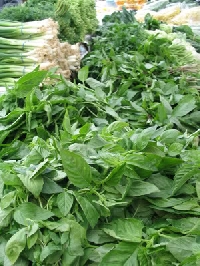Growing your own herbs
By Catalogs Editorial Staff
Table of Contents

Growing your own herbs to makes every dish you cook taste better
There is nothing quite as delicious as a meal made with freshly picked herbs. Unfortunately, most of us don?t have an herb garden in our kitchens, so we resort to dried, irradiated grocery store herbs with little of the original flavor left.
Guess what? You CAN have fresh herbs! Whether you have acres of land or just a sunny windowsill in your kitchen, growing your own herbs is a lot easier than you might think.
Start with what you like
Are you a fan of Italian or Mediterranean cooking? You’ll probably want to consider oregano, basil and rosemary for your herb garden. If you lean towards Asian cooking, lemon grass, garlic chives and cilantro are probably higher on your list. Or for a lighter, California-style of cooking consider dill, lemon basil, chervil, or summer savory.
Pick a theme, or mix and match your personal favorites.
Decide on a location
A kitchen garden
Traditionally, herbs were grown in a kitchen garden, a plot of land just outside of the kitchen door. That made it easy for cook to step outside a pick whatever was needed for the next meal.
With today’s busy lifestyles and hectic schedules, a kitchen garden might be just the right choice. A kitchen garden can be any size, but a plot of about 20′ by 4′ will allow you ample room for individual 12′ x 12′ plots to separate your herbs, with room for irrigation and boundaries. You will need to invest in just a few quality garden tools in order to plant and tend your plot.
You can also create a border of some of the more colorful and frequently used herbs, such as parsley, dill, sage and purple basil. Consider keeping annuals and perennial herbs separate to make it easier to plan for replanting each year.
If you’re using seeds to start your garden, mark off the areas with string, and create a diagram of the area so you’ll be able to tell what’s an herb and what’s a weed!.
~
An indoor garden or container garden
If outdoor space is limited, or you prefer year-round access to fresh herbs, and indoor or container herb garden might be a better choice for you. The good news is that even a tiny windowsill garden can yield enough fresh herbs for an ordinary family’s cooking needs.
Growing your own herbs indoors, or in pots on your patio or balcony requires that you give a little more attention to soil, drainage, light and watering than you would if creating an outdoor garden.
Make sure your pots or containers allow for proper drainage. Herbs with soggy roots will quickly die. In addition to drainage holes, place some large rocks or broken flower pot pieces in the bottom of each pot to allow for easy drainage. Use a loose soil to avoid compacting the roots and stunting growth.
Check the instructions for each type of herb to find out its need for water and sunlight. Some herbs prefer quite dry conditions, while others only thrive in moist soil.
Most herbs need a significant amount of sunlight. If your windowsill or balcony is shaded, invest in a grow-light to provide the needed hours of light for optimal growth.
Using herbs as landscaping
Another outdoor option breaks free from the bounds of the traditional garden plot. Herbs come in a huge variety of shapes and sizes, some with colorful flowers, others with elegant or feathery leaves.
This approach has several benefits. Not only are most herbs hardy and easy to maintain, but using herbs as a part of your landscaping allows you to better plan and use water resources for plants that provide more than just a decorative element. And many herbs act as natural insect repellents, reducing the need for using potentially toxic chemicals on nearby flowers and shrubs.
Growing your own herbs can save you money
In today’s economy, every dollar counts. Growing herbs at home is a wonderful way to combine good taste with money savings. One herb plant could easily provide as much seasoning as four or five bottles of dried, store bought herbs, but for a fraction of the cost.
Popular Savings Offers











